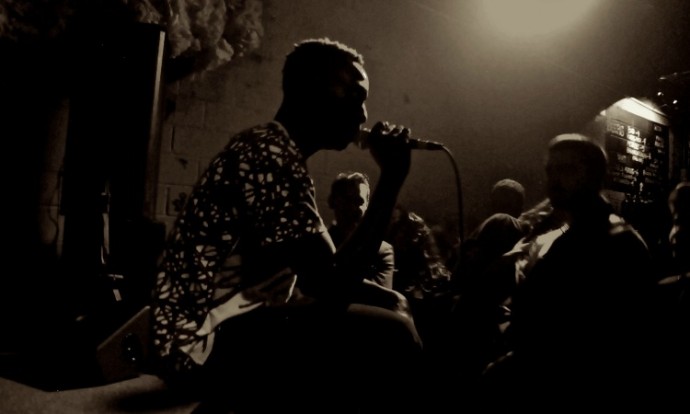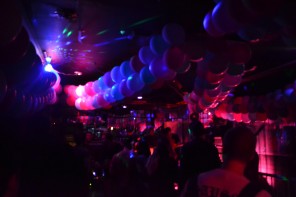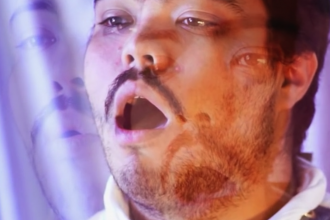This is an adaptation of a paper I had to write during my junior year at NYU. The assignment dictated to observe a public space and make extensive field notes (the politics of objects, non-verbal communication, semiotics, identity) on both the physical space and the people contained within. There’s something to be said about a space where the communal purpose is to experience art, especially art that instills a spirit of adrenal anarchy or personal significance. The sense of escapism and evocation that art provides was not present in the class readings, which made it hard to grapple with the concepts introduced for the purpose of this essay, since the live experience of art is different than the politics of a hotel lobby or coffee shop. A live performance, particularly one in a small DIY venue, presents a confounding of the front stage and the back stage; of the intimate and the public. I’ve also removed every mention of the name of the acts playing – what matters here is not promoting or specificity, but the examination of the shared experience of performance.
The venue in question is called Glasslands, and it, like the other several notable venues populating the waterfront of South Williamsburg, is doomed. Faced with a slew of legal and regulatory issues, as well as rising rents, the venues will close before the new year, following suit after its fallen neighbor 285 Kent’s farewell earlier this year. Though it hosts a wide variety of musical acts, tonight’s headliner is a punk band, and the vibe of the crowd is radically different than the honeyed pop bands and electronic music producers featured on other evenings. The lighting is intentionally low and foreboding, obfuscating the finer details of the room; the anticipatory glances from the crowd, the small profanities of graffiti scrawled incoherently across bathroom stalls, small pieces of trash littered on the concrete floor. The venue was made with DIY ethos, absent of the corporate polish and legal consciousness of its Manhattan contemporaries. This is embodied physically in the acoustically inefficient concrete walls, beer served in solo cups, and the faint scent of marijuana.
A glowing exit sign is lost in the ambience, doing little to counteract the darkness. In a room like this it is easy to get lost in the shadows, to slip into the tepid anonymity of swaying bodies. There are several hundred people assembled, an amalgamation of young Brooklynites and leather boots. In such a dingy and windowless chamber, heat from bodies makes the room stuffy and self-contained. The air feels heavy; not with oxygen, but with the collective body heat and slurred speech of its patrons, the carbon dioxide of forgotten utterances. The room smells like wet leather, cheap beer, stale cigarette, and human. These are the objects that make up the aesthetic of the space: the sights, smells, and ambiance.
There is something to be said about the more intangible aspects of “feeling the music”, and certainly such an engrossing experience ignites feelings of insurgency and self-reflection.
Indeed the crowd assembled at Glasslands are willing participants of one or many subcultures and aesthetics – the Brooklyn DIY venue crowd, the musicians and the stoners, people who like “punk music” – yet there is a comforting commonality to the assemblage of the misfits. In this space these small objects and signifiers (leather, spiked jackets, heavy boots, an aura of contempt) become metrics for assimilation into the concert space. There is a short lull before the headliner ascends the stage – a smattering of sound checks and unloading gear onto the stage without the faintest degree of formality or professionalism. The crowd mingles and mutters, exchanging bits of conversation or affirmation that will soon be drowned in deafening amplifiers and screeching guitars. As the band begins to play, the fringes of the crowd make way for the thrashing innards of a mosh pit – the music is filled with rebelliousness and discontent, and the sound is encompassing. Even shouted conversations are inaudible beneath the tempestuous music, and one has no choice but to succumb to the crowd and become one of the writhing masses. There is something to be said about the more intangible aspects of “feeling the music”, and certainly such an engrossing experience ignites feelings of insurgency and self-reflection. There is also an intangible aura of sadness – this is the last punk show to be hosted on the Williamsburg waterfront, the death of a scene.
Martin Heidegger writes “to dwell is to garden”. He investigates this etymologically – the German word for build is bauen, and also relates to nearness and neighborliness, which Heidegger describes as “to cherish and protect, to preserve and care for”. Its etymological roots remain tied to the Old High German baun, which means “to dwell” in the sense of remaining or staying in place. In emphasizing this link to place, Heidegger suggests that physical buildings relate to dwelling, which therefore can be said to involve a sense of continuity, community, and at-homeness – Heidegger argues that dwelling hinges upon sparing and preserving, empathy for creatures and beings as they are and as they can become. Is moshing the embodied manifestation of this dwelling? To an outsider, the behavior would seem violent and volatile, but there is an intangible solidarity to the pit – there is a community that has built itself around this scene, an imperceptible at-homeness to the assemblage who normally are outcast or stifled by the mainstream.
To them, moshing is gardening. Not only cultivating an aesthetic or a subculture identity, but fostering a public community of commonality in art. Perhaps what makes the concert experience so powerful is the sense of shared collectivity with the surrounding strangers. Though the emotions evoked by the music may resonate differently within individuals, the sense of a collective emotional bonding experience (in this case, one of contempt and rebellion) create an intimacy within the space despite the trepidation of the mosh pit.
I step outside, dizzy with sweat and bruised shoulders. Glasslands is the sole survivor of the DIY scene, the defeated concrete of 285 Kent and Death By Audio boarded up and silent. Just a year ago the spot I am standing in would have been filled with tepid youth smoking cigarettes and shuffling feet, but tonight the block is subdued. Across the street there is a crowd of middle aged women outside an Italian restaurant and a bearded man walking his Mastiff. The Williamsburg gentry now vastly outnumbers the handful of people on the block there to experience music. Glasslands was the most neutered of the venues, dutifully checking IDs and keeping bathrooms up to regulation, and lacked the Wild West appeal of its neighbors. Yet, despite its attempts to stay afloat, Williamsburg has outgrown Glasslands and swallows it up to regurgitate VICE Headquarters and a preschool for the arts.
The participants are not angry with each other and do not seek to levy violence upon each other, but rather physically manifest the violence they feel within themselves.
Heidegger argues that, in our modern age, human dwelling is reduced and so, therefore, is building. His explication of why we dwell less fully today is complicated; he suggests that, in part, it is because we manipulate and demand from our world rather than meet it an attitude of sparing and preserving‑‑i.e., allowing it to be and become. The music allows the participants to take the front stage, embody and communally demonstrate their frustration and apathy that is usually reserved for private moments. The participants are not angry with each other and do not seek to levy violence upon each other, but rather physically manifest the violence they feel within themselves. Perhaps it is a small act of anarchy against the society that stifles them, or the physical demonstration of internalized anger from this frenzied assemblage. It is a demonstration of solidarity, rather than animosity: the act of the moshing is profoundly intimate. There is no judgment or decorum, only to be.
The performance is a shared experience, a safe place where Brooklyn’s tepid youth can unite in commonality through art. It’s unclear what the rebellion is against – the government, the NYPD, the man, one’s own self. Ultimately, it doesn’t fucking matter. Instead of harboring resentment, the mosh pit presents a culture that accepts and shares these grievances, and embraces them without judgment or pretension. Rami Haykal, the proprietor of Glasslands and founder of DIY booking agency Popgun, said “It was 285 because a group of people willed it into existence. That’s what gives venues character: the people who build them and the choices they make.” The music provides a dwelling, a place to take comfort in these feelings and frustrations: perhaps there is no common enemy, but there is a common community and togetherness.
In just a few weeks the venue will close down, and the scene will be no more. Crowds of starry-eyed Brooklynites and rowdy musicians will no longer roam the Kent Ave waterfront, smoking cigarettes and exchanging tidbits of knowledge about upcoming shows. A row of what used to be empty warehouses now contains an ice cream shop, yoga studio, and an American Apparel. Like a bad gentrification nightmare realized, the people that called this foreboding row of warehouses home are now the misfits interrupting the flow of strollers and incoming condo developments. Glasslands is the last venue standing on this small block, and will soon only exist immortalized in Pitchfork articles bemoaning the nostalgia of the DIY scene and the distant memories of the people that were lucky enough to experience it. John Dwyer of Thee Oh Sees said, on the death of the scene, “Nothing gold can stay, but that whole group of people are contributors, so they’ll all be back. They’re like weed. They’ll grow anywhere.” Though there will be other venues, there is a strange nostalgia for this forlorn block of warehouses. When I moved to NYC, finally unbound from the suburban perpetuity of my nowhere hometown, I too found comfort in the music venues on this block and assimilated it into my identity. I spent nights bonding with strangers over a cigarette, tangling with sweaty bodies, and meeting people I now call friends. My story isn’t unique, and that’s what makes the scene special, both to me and in the greater scheme of things. This dwelling was a frontier of people with common interests (the misfits, the subcultures, the angsty youth) to do exactly as Heidegger said: to be and become.
Führ, Edward. Building and Dwelling [Bauen und Wohnen] Munich, Germany: Waxmann Verlag GmbH; New York: Waxmann, 2000, pp. 189-202;
Harries, K. 1983. Thoughts on a Non‑Arbitrary Architecture. Perspecta, 20, 9‑20; reprinted in Dwelling, Seeing, and Designing, D. Seamon, ed. Albany, NY: SUNY Press, pp. 41-59.
Heidegger, Martin, 1971. Poetry, Language, Thought. New York: Harper and Row.
Maloney, Devon. “Articles: Indestructible Room: The Story of 285 Kent.” Pitchfork. Pitchfork Media, 17 Jan. 2014. Web. 11 Dec. 2014.
Seamon, David. “Concretizing Heidegger’s Notion of Dwelling: The Contributions of Thomas Thiis-Evensen And Christopher Alexander.” Archive. KSU, n.d. Web. 11 Dec. 2014.
Warner, Michael. Publics and Counterpublics. New York: Zone, 2002. Print.
Photos courtesy of Kate Millet.





